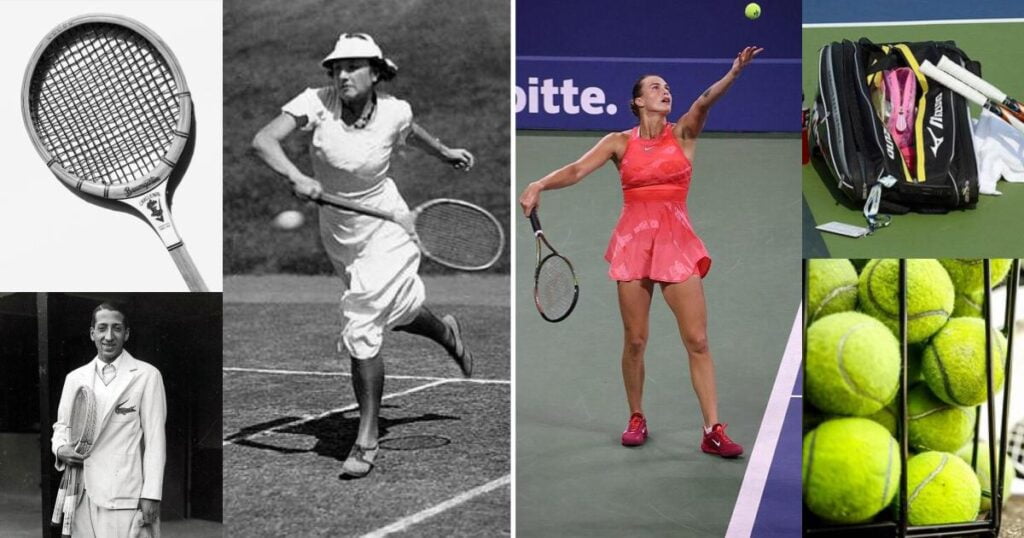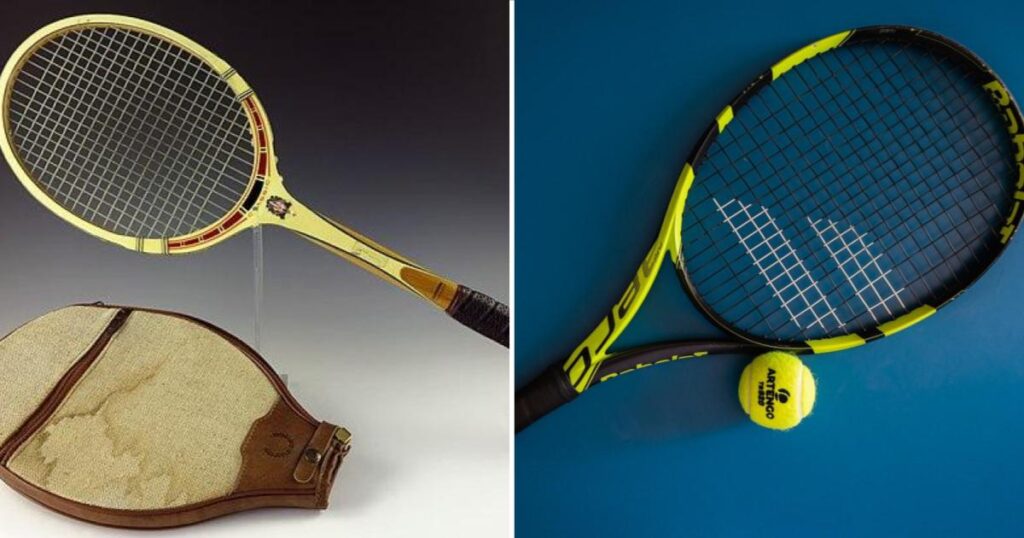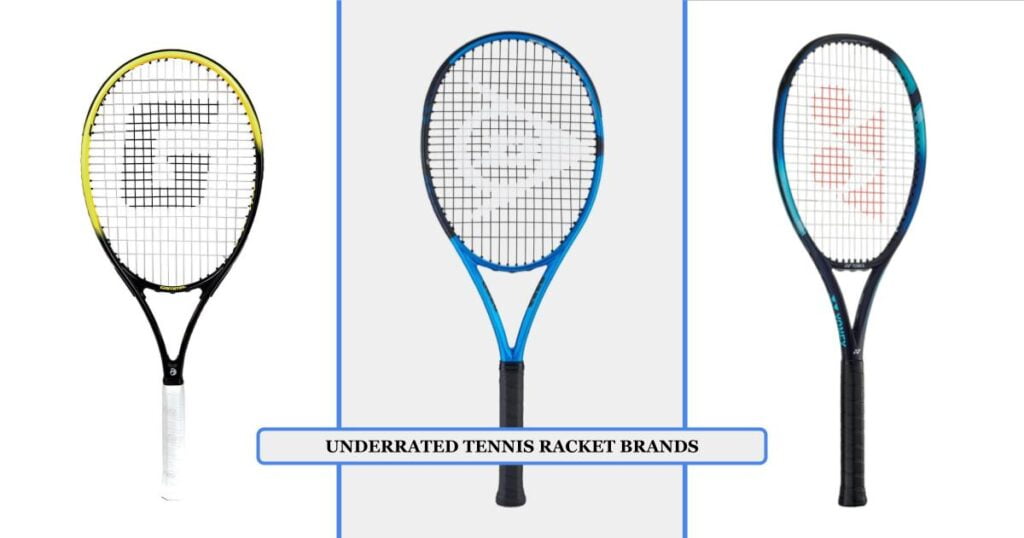Tennis is a sport with a history of more than 600 years, making it one of the oldest sports in the world. Over the years, tennis has undergone immense changes and has become increasingly competitive. Well, that’s how a sport gradually evolves over time to stay relevant and suit the preferences of sports fans. As tennis has evolved, the equipment that supports the sport has also evolved..
In this post, we will examine how tennis equipment has changed over the years. We will discuss how older processes and materials used to make this equipment have been replaced by advanced technologies and durable materials.
1. Racket

The tennis racket has undergone perhaps the most changes throughout the evolution of the sport. In today’s time of technology and innovation, racket makers are constantly researching ways to improve their performance and enhance their potential. In one of our blog posts, we discussed in detail the evolution of the tennis racket and compared modern and wooden rackets. You will find it interesting.
The “Cork” Era
From playing with bare hands to using rackets, tennis has undergone immense changes throughout its evolution. Before the 14th century, tennis was played with bare palms in northern France. That resulted in hand injuries, as expected, so the players started using gloves to protect themselves from injury. But it is in the 15th century in which we can find the use of traditional rackets made from cloth-coated cork in cloth and strings made from sheep’s intestines. The cloth then got replaced by leather.
The “Wood” Era
Next comes the laminated wooden racket, which was designed around 1947. The racket was made from pieces of wood glued together, not from a single piece of wood. If we go back a little in time, we will find that the first racket made of solid wood with a leather grip was designed by Major Walter Clopton Wingfield in London in 1874. After the late 1980s, wooden rackets began to disappear from professional-level tournaments.
The “Metal” Era
The first metal racket was made of steel. Further research in racket technology has given us the modern rackets we use today, which are made of graphite and because graphite is lighter than steel, which caused the weight of rackets to change drastically. The first graphite racket was manufactured by Prince Sports, a sporting goods manufacturer from the US.
From bare hands to wooden rackets to metal ones, tennis rackets have undergone major changes over the years. In the future, as the world looks for eco-friendly and sustainable alternatives, we can expect rackets to continue to change.
2. Tennis Balls
The history in regards to tennis balls dates back to the 13th century. Back then French people from nobel backgrounds started playing tennis. As mentioned earlier the balls used to be made with the help of a cork wrapped tightly in strips of wool. In the late 18th century the first time a major advancement happened when processed rubber was used. In the year 1926 first pressurized ball was made by The Pennsylvania Rubber Company which was a prominent supplier of balls for different sports.
Was the color not always yellow?

It might surprise some that the color of tennis balls did not turn to yellow until 1972. The International Tennis Federation (ITF) introduced yellowish tennis balls, but the reason for the change had nothing to do with the players; it was due to the poor visibility of white balls on television, especially for viewers with color television sets. Wimbledon also took note of these new balls and introduced yellow balls in 1986.
In the coming years, we will see a preference for environmentally friendly materials to be used in tennis ball manufacturing, as preserving our environment is the need of the hour.
Tennis balls, like other equipment, have undergone changes in the materials used to make them but when it comes to the size of tennis balls, we don’t see any major changes.
3. Tennis String

Natural gut strings
Tennis strings were made from animal intestine in the early days of the sport, when it was played by only a few countries. This was the most readily available material at the time. Strings made from “natural gut” were widely used until the 1950s.
Synthetic strings
After the mid-19th century, the most prominent change in tennis strings occurred when synthetic materials such as nylon and polyester began to be used. The popularity and acceptance of synthetic strings grew in the next few decades. The switch from natural gut to synthetic material was also beneficial for two main reasons: durability and lower cost.
The change in materials used for racket strings from natural gut to synthetic is an integral change that has occurred over the years. The sourcing of animal gut and the associated costs, both direct and indirect, have dropped substantially due to the use of synthetic materials. Also, with natural gut strings, durability was a problem, so tennis rackets back then were not durable, which increased the cost of making and buying them.
4. Tennis Court & Surface

Tennis as a sport began to gain recognition in the mid-18th century. This was because, from its origin, the sport was popular among European monks, who played it in unroofed areas enclosed by walls. Then it gradually started to gain recognition from other European countries. Tennis used to be played on hard wooden and stone surfaces, so its reach was limited to certain countries and regions.
The origin of lawn tennis can be traced back to 1874, when the first lawn tennis match was played in Denbighshire, England. Clay courts, on the other hand, have been used since the late 18th century.
During the late 1800s, the Renshaw brothers, twin tennis players from England, used a terra cotta coating to safeguard their grass court from high temperatures. Terra cotta, as we know, is a type of clay used in pottery to make vessels and other objects. This experiment of theirs is said to be how clay courts started to be used for tennis.
5. Net

The net in tennis has also undergone changes over its history, though not as significantly as some other equipment. In earlier times, when tennis was not typically played indoors, the net was much higher than it is today. The current regulation height of the net is 3 feet in the middle and 3.5 feet at the posts. Nets used to be made of cotton, but today they are made from nylon and other composite materials.
6. Ball machine

Unknown, PHOTO © POPPERFOTO – GETTY, CC BY-SA 4.0, via Wikimedia Commons
“Didn’t see that one coming?” This is what tennis players use as an excuse when they miss a shot from the tennis ball machine. Just kidding! In all these years, the pace at which tennis is played has increased, and so has the speed of ball machines.
Famous French tennis player René Lacoste patented the first manual ball machine in 1920. The machine’s mechanism was simple but effective, given the time period in which it was invented. It took three decades for ball machines to go electric, which incidentally increased the delivery of balls substantially.
In 1968, the founder of the Prince company, Robert McClure, innovated the machine further by incorporating a motor to add air pressure. Prince’s machines received the recognition they deserved and were sold on a large scale. Over the years, tennis equipment manufacturers have continued to innovate ball machines, which has increased the cost of both purchase and maintenance.
Current ball machines are portable and have increased capacity in terms of the number of balls delivered per session. They can now be managed and customized from the palm of your hand using mobile apps. Various aspects, such as speed, spin rate, inclination, and elevation, can be adjusted to meet the player’s needs.
7. Racket Handle & Grips

Leather grips have long been used for tennis racket handles, and many tennis players still prefer them today. However, due to the increasing preference for sustainable products, leather has been replaced by similar materials such as vinyl, rubber, and synthetic polymers. Leather overgrips were introduced in the 1930s.
Tennis racket handles were originally made of wood, which remained in use for a long time. In modern tennis rackets, graphite is an important material that provides the necessary durability and stiffness.
8. Vibration Dampener

French tennis player René Lacoste was the first to patent vibration dampeners for metal tennis rackets in 1960. Vibration dampeners are small devices made of rubber and synthetic materials that are used in a tennis racket to absorb vibration and shock when a ball hits the racket. Vibration from the racket transfers to the player’s arm, causing pain over time. Dampeners are placed in the string bed near the throat of the racket. Today’s dampeners are made of silicone, which has better shock-absorbing properties than rubber.
9. Tennis Bags

Today, tennis bags are a medium for promoting sponsors for many professional tennis players. However, this was not the case in earlier days, when bags were used to carry tennis rackets and a handful of other items. Today, the number of accessories has grown, and so has the size of bags. Sports equipment companies like Babolat, Adidas, and Head make personalized bags that suit the needs of tennis players.
10. Tennis Shoes

Probably the most important accessory for tennis players is the shoes. In a high-intensity game like tennis, where players have to make sudden movements in a split second, a lot depends on the shoes and how much flexibility they provide. In the earliest days, tennis shoes were made of canvas, a woven fabric, with soles made from rubber. The first major company whose tennis shoes became popular was the United States Rubber Company, under the brand name “Keds,” in 1916. Compared to old tennis shoes, modern shoes are lighter in weight simply because of the materials used to manufacture them. Modern tennis shoes are designed with player safety and optimal movement in mind. For instance, the toe guard, which is made from materials such as rubber or PVC, protects the toe box. The midsole is where lightweight materials are used to keep the shoes lightweight. The soles are made from materials such as foam, cork, and leather.
11. Stringing Machine

Before the arrival of stringing machines, rackets used to be string manually by hand. Stringing machine was first patented in the year 1932 in the name of W.E. Jaffe of Chelsea from England. The first electric stringing machine was introduced by Babolat, sports equipment producers in the year 1981. The major difference between old stringing machines and modern ones is time saving. Today’s machines save a lot of time to string rackets and it also increases productivity.
12. Tennis Ball Hopper
Tennis camp instructor Jake Stap invented the tennis ball hopper in the 1960s for the very reason it is used today: to collect balls that are spread across the court. The tennis ball hopper is an effective way to collect balls without having to bend over repeatedly. When the bars across the bottom are pressed against a ball, the ball squeezes through to the basket. In recent times, tennis ball hoppers have undergone design changes, and new versions with different shapes and sizes are now available. Here are some of the options available in the tennis ball hopper category:
- Wheeled tennis ball cart
- Tennis ball roller
- Tennis ball tube
The latest addition to the list is a robotic tennis ball collector. The machine is powered by artificial intelligence, which allows it to detect and collect balls automatically.
13. Clothing

During the early 1900s, tennis players, especially female players, wore regular clothes during matches, which were mostly similar to the fashion of the time. Today, that is not the case. Tennis governing bodies lay down certain regulations when it comes to tennis clothes. In olden times, clothes made from cotton were often heavy, especially for female athletes who wore floor-length skirts, and for men who wore full pants instead of the shorts they wear today.
Tennis clothes were not tailored for the player’s comfort or mobility in the past. Today, tennis clothes are made with various aspects of the game in mind, such as best fit, better mobility, climate conditions, and personal preferences. Today, sportswear makers use synthetic fibers in fabrics to make lightweight clothing.
Most tennis clothing brands now use moisture-wicking technology. Fabrics made with this technology pull sweat away from the body and evaporate quickly.
14. Safety Equipment

According to studies, the rate of tennis injuries ranges from 2 to 6 per 1,000 hours of play. Every sport that is professionally played today began as a hobby at some point, and athletes later pursue it as an amateur. Tennis was no different and went through the same process. The more competitive a sport is, the greater the chances of injury. Tennis, in particular, is played with fierce energy, even in less competitive environments. Even though professional tennis players today follow a stringent fitness regime, they are still prone to injuries due to the competitive nature of the sport.
Safety equipment has increased in number over the past 100 years as the sport of tennis has evolved and the difficulty level has increased. Here are some instances in tennis history regarding safety equipment:
- Martina Navratilova started wearing eyewear in 1985 due to declining eyesight.
- British tennis player Fred Perry was one of the first players to start wearing wristbands in the early 1930s.
- The injury tapes that we see tennis players apply to injured body parts during matches were not invented before the 1970s.
- Adidas was the first to brand a shoe as a tennis shoe in 1931. Before that, Keds sneakers were a popular choice among tennis players.
- Compression sportswear worn by tennis players became popular in the late 1990s.
This evolution and new inventions of tennis equipment have certainly made the lives of tennis players easier than those of yesteryear players. This also shows that tennis players in older times faced far more difficult scenarios and conditions than those of today. Of course, that does not mean today’s tennis players don’t have challenges. Each phase of evolution provides us with new challenges that everyone deals with in their own way. That’s how things evolve.
The future is all about technology, and we have certainly already begun to experience the changes happening in the sport of tennis due to technological advancements. We will continue to see this beautiful sport evolve even further in the future, but this time the pace will be as rapid as Serena Williams’s serve, for sure.
Also see:
Underrated Tennis Racket Brands That Offer Great Value
A Comprehensive Comparison of Modern Tennis Rackets and Old school Models
Tags: Tennis Insights
featured image credit:
Hameltion, CC BY-SA 4.0, via Wikimedia Commons
Steven Pisano from Brooklyn, NY, USA, CC BY 2.0, via Wikimedia Commons






